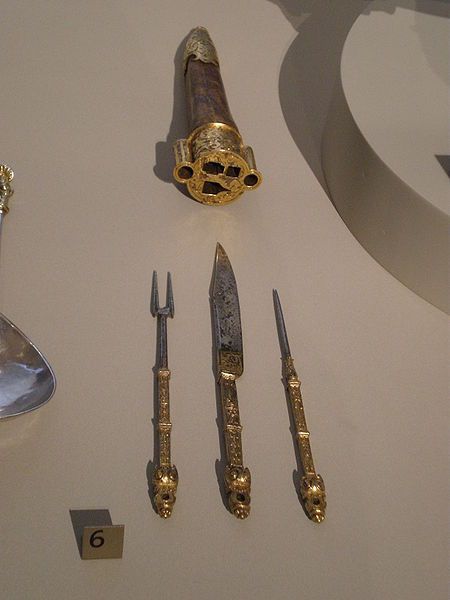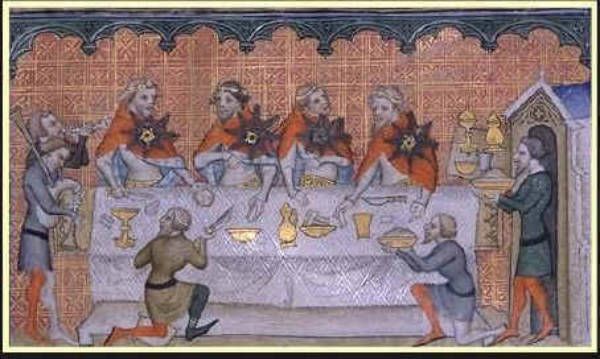 Of
the three eating utensils we normally use, only forks have a modern
origin. Knives and spoons are prehistoric- but as recently as 1800,
forks weren’t commonly used in America. Some food for thought…
KNIVES, BUT NO FORKS
Of
the three eating utensils we normally use, only forks have a modern
origin. Knives and spoons are prehistoric- but as recently as 1800,
forks weren’t commonly used in America. Some food for thought…
KNIVES, BUT NO FORKS
Centuries
ago, few people had ever heard of a “place setting.” When a large piece
of meat was set on the table (sometimes on a platter, sometimes
directly on the table), diners grabbed the whole thing with their free
hand… then pulled out a knife and sliced off a piece with their other
hand. Most eating was done with fingers: Common people ate with all
five, while nobles -who understood sophisticated table manners- ate with
only three (thumb, forefinger, and middle).
At that time, there
were no utensils. In fact, most men owned just one multipurpose blade,
which, in addition to carving food, was used for fighting, hunting, and
butchering animals. But wealthy nobles had always been able to afford a
different knife for each purpose, and by the Middle Ages, they had
developed a setting of
two knives, for very formal dining. One
knife was thrust into a large piece of meat to hold it in place on a
plate, while the second was used to cut off a smaller piece, which the
eater speared and placed in is mouth.
FORKS
One
of the drawbacks of cutting a piece of meat while holding it in place
with a knife is that the meat has a tendency to “rotate in place like a
wheel on an axle,” Henry Petroski writes in
The Evolution of Useful Things.
“Frustration with knives, especially in their shortcoming in holding
meat steady for cutting, eventually led to the development of the fork.”
The name comes from
furca, the Latin word for a farmer’s pitchfork.
The
first fork commonly used in Europe was a miniature version of the big
carving fork used to spear turkeys and roasts in the kitchen. It had
only two “tines” or prongs, spaced far enough apart to hold meat in
place while cutting it; but apparently it wasn’t something you stuck in
your mouth and ate with -that was still the knife’s job.
A FOOLISH UTENSIL

Those
first table forks probably originated at the royal courts of the Middle
East, where they were in use as early as the seventh century. About
1100 AD they appeared in the Tuscany region of Italy, but they were
considered “shocking novelties,” and were ridiculed and condemned by
clergy, who insisted that “only human fingers, created by god, were
worthy to touch god’s bounty.” Forks were “effeminate pieces of finery,”
as one historian puts it, used by sinners and sissies but not by
decent, God-fearing folk.
“An Italian historian recorded a dinner at which a Venetian noblewoman used a fork of her own design,” Charles Panati write in The Extraordinary Origins of Ordinary Things,
“and incurred the rebuke of several clerics present for her ‘excessive
sign of refinement.’ The woman died days after the meal, supposedly from
the plague, but clergymen preached that her death was divine
punishment, a warning to others contemplating the affectation of a
fork.”
FORK YOU

Early French Forks
Thanks
to these derogatory associations, more than 250 years passed before
forks finally came into wide use in Italy. In the rest of Europe they
were virtually unheard of. Catherine de Medici finally brought them to
France in the 1500s when she became queen. And in 1608 an Englishman
named Thomas Coryate traveled to Italy and saw people eating with forks;
the sight was so peculiar that he made note of it in his book Crudities Hastily Gobbled Up in Five Months:
The
Italians… do always at their meals use a little fork when they cut
their meat… Should [anyone] unadvisedly touch the dish of meat with his
fingers from which all at the table do cut, he will give occasion of
offense unto the company, as having transgressed the laws of good
manners, insomuch that for his error he shall be at least browbeaten if
not reprehended in words… The Italian cannot by any means indure to have
his dish touched with fingers, seeing all men’s fingers are not alike
clean.
Coryate brought some forks with him to England
and presented one to Queen Elizabeth, who was so thrilled by the
utensil that she had additional ones made from gold, coral, and crystal.
But they remained little more than a pretentious fad of the royal
court.
Fork Use 1624
Forks
became more popular during the late 17th century, but it wasn’t until
the 18th century that they were widely used in continental Europe as a
means of conveying food “from plate to mouth.” The reason: French nobles
saw forks as a way to distinguish themselves from commoners. “The fork
became a symbol of luxury, refinement, and status,” writes Charles
Panati. “Suddenly, to touch food with even three bare fingers was
gauche.” A new custom developed- when an invitation to dinner was
received, a servant frequently was sent ahead with a fine leather case
containing a knife, fork, and spoon to be used at dinner later.
MAKING A NEW POINT
Édouard Manet's Oysters 1862
But
before this revolution took place, the fork had to be redesigned. The
first forks were completely useless when it came to scooping peas and
other loose food into the mouth- the gap between the tines was too
large. So cutlery makers began adding a third tine to their forks, and
by the early 18th century, a fourth. “Four appears to have been the
optimum [number],” Henry Petroski writes in The Evolution of Useful Things.
“Four tines provide a relatively broad surface and yet do not feel too
wide for the mouth. Nor does a four-tined fork have so many tines that
it resembles a comb, or function like one when being pressed into a
piece of meat.”
COMING TO AMERICA
One of
the last places the fork caught on in the Western world was colonial
America. In fact, forks weren’t even commonly used until the time of the
Civil War; until then, people just ate with knives or their fingers. In
1828, for example, the English writer Francis Trollope wrote of some
general, colonels, and majors aboard a Mississippi steamboat who had
“the rightful manner of feeding with their knives, tip the whole blade
seemed the enter the mouth.” And as late as 1864, one etiquette manual
complained that “many persons hold forks awkwardly, as if not accustomed
to them.”



No comments:
Post a Comment